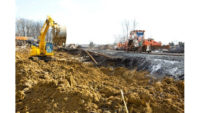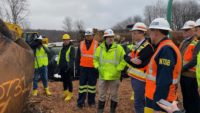Norfolk Southern Railroad has provided Ohio environmental officials with a proposed action plan to remediate environmental damage stemming from a Feb. 3 freight train derailment and ensuing fire in East Palestine, near the Pennsylvania border, which released toxic chemicals into the air, soil and water, forcing hundreds of residents to evacuate.
Developed and submitted on the railroad’s behalf by Arcadis US Inc., the plan aims to build on response measures implemented in the hours and days following the mishap. The National Transportation Safety Board, which is investigating the incident, has confirmed that a mechanical issue with one of the rail car axles caused about 50 of the 150-car Norfolk Southern train to leave the tracks.
No on-board train personnel were injured, and the remainder of the train was immediately decoupled and moved out of the area.
According to the U.S. Environmental Protection Agency (EPA), approximately 20 untracked rail cars were listed as carrying hazardous materials, including vinyl chloride, butyl acrylate, ethylhexyl acrylate and ethylene glycol monobutyl ether. Two days after the derailment, Norfolk Southern responders conducted a controlled release of vinyl chloride from five cars to prevent a potential explosion. The chemical was diverted to a trench where it was burned off.
Norfolk Southern emergency response contractors also installed booms and underflow dams in two nearby streams to restrict the flow of contaminated water as well as contain and collect floating product. Recovery operations used a vacuum truck and sorbent pads. Surface water was treated using aeration pumps and a mobile granular activated carbon treatment unit, according to the action plan.
To date, the action plan says, “approximately 180,000 gallons of separate-phase liquids and water have been collected from the derailment site, and are currently stored in nine fractionation (frac) tanks pending characterization and offsite transportation and disposal. Two 20-cu-yd roll-off containers of butyl acrylate and petroleum impacted absorbents are also staged onsite pending characterization and offsite transportation and disposal.”
Since the derailment, air monitoring by the EPA has detected no airborne contaminants beyond levels of concern, though residents continue to complain of unusual odors. Results from surface and well-water monitoring, which is being overseen by the Ohio Environmental Protection Agency, are pending, though no restrictions on water use are in place.
Soon after the derailment, West Virginia American Water said that while there had been no change to its primary Ohio River intake, located downstream from East Palestine, a secondary intake would be established on a tributary river.
EPA notified Norfolk Southern in a Feb. 10 letter that the railroad may be liable for site cleanup costs arising from the derailment, including those already incurred by the agency.
The railroad’s remedial action work plan says that data from soil sampling and installation of a groundwater monitoring well network will help refine future remediation strategies. It notes that, while “the precise nature and extent of impacts requiring remediation is not fully known,” the overall objectives of contaminant removal and protection of human and ecological health, “may be achieved through a combination of active engineered efforts (e.g., soil excavation or in situ treatment), engineering, institutional and administrative controls and natural systems (e.g., monitored natural attenuation).”
Yet to be determined, however, is how long the remediation effort will last. The action plan says the scope and schedule for the work “is heavily dependent on the results of ongoing site restoration and characterization.” For example, the onsite well network cannot be established until site restoration and large-scale soil removal around the derailment area are completed. Possible approaches to accelerate the pace of groundwater sampling and study are under consideration, while surface water treatment and free-phase liquid treatment will continue on a daily or continuous basis until modified by a future agreement with Ohio EPA.
Norfolk Southern has also provided no estimate as to when the rail corridor where the derailment occurred will be restored to freight traffic. The corridor handles freight shipments between the upper Midwest and the Northeast, including those involving the Port Authority of New York and New Jersey.





Post a comment to this article
Report Abusive Comment